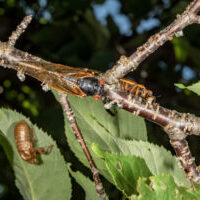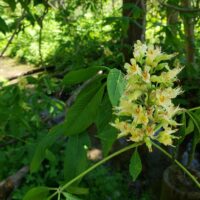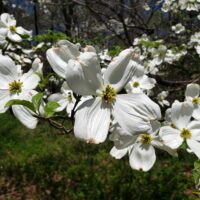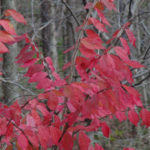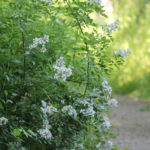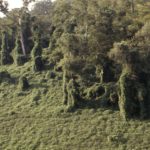 Purdue University - Extension - Forestry and Natural Resources
Purdue University - Extension - Forestry and Natural Resources
Got Nature? Blog
Purdue Landscape Report: Hoosiers are in for a special treat this spring. If you have lived in Indiana for more than a year, you have probably grown accustomed to the singing of cicadas in the later days of summer. However, in some years, cicadas will emerge in the spring. This occurred in 2021 when most of the state was inundated in periodical cicadas as Brood X emerged from their 17-year development. This year, two broods will emerge concurrently: Brood XIII and Brood XIX. Brood XIII is a 17-year cicada, while Brood XIX is a 13-year cicada. The emergence of these two broods isn’t unusual, but this year is special because they will asemerge at the same time. Their schedules haven’t aligned for over two hundred years! The last time these two cicada songs were heard together, Thomas Jefferson was in the White House. While this may sound like Indiana is about to be covered in cicadas, there are a few facts that may change your expectations.
There are two types of cicadas in the Midwest: annual cicadas and periodical cicadas. Annual cicadas, as the name implies, are seen each year. They normally spend two to five years underground, but there are enough of them that we see them emerge each year. Annual cicadas emerge individually, not as a group, and we see them towards the end of the summer, thus their other common name, “dog day cicadas”. Periodical cicadas have a much different life cycle. They remain in the ground as nymphs for either thirteen or seventeen years, feeding on the roots of the trees they will eventually climb. Around April, the broods will emerge together using a combination of temperature and their own internal clock. Both types of cicadas feed on deciduous trees and tend to inhabit areas where eggs were laid during previous emergences, giving them a low likelihood of moving to new areas. Annual cicadas are green with black eyes, and periodical cicadas have dark-colored bodies with red eyes and orange legs, making it easy to differentiate them as we enter the early summer and both types are present.
The term “brood” cicada biology is referring to a group of cicadas that share the same developmental time and the same physical area. A brood will often contain several different species, though they will all belong to the genus Magicicada. Cicadas in a brood do not need to be genetically related to each other. Some broods are very small and cover a small area, whereas others can cover a significant portion of the Midwest. For example, Brood XII, a brood of 17-year cicadas, last appeared in 2023 and has only been detected in Allen and Orange counties. On the other hand, Brood X, also known as the Great Eastern Brood, covers the entirety of Indiana and several other states. Brood XIII and Brood XIX both cover several states, but they will have very little overlap in Indiana. Only eight western counties, between Posey and Jasper counties, will experience Brood XIX, and three northern counties (Lake, LaPorte, and Porter) will see Brood XIII. Nowhere in Indiana do the broods overlap. Essentially, while there will be a lot of cicadas emerging all at once, the lack of overlap will mean this emergence will be notable, but nothing compared to the Brood X emergence a few years ago.
To view this full article and other Purdue Landscape Report articles, please visit Purdue Landscape Report.
Subscribe and receive the newsletter: Purdue Landscape Report Newsletter.
Resources:
Periodical Cicadas, Indiana Department of Natural Resources, Division of Entomology
Billions of Cicadas Are Coming This Spring; What Does That Mean for Wildlife?, Got Nature? Blog, Purdue Extension-Forestry and Natural Resources (FNR)
17 Ways to Make the Most of the 17-year Cicada Emergence, Purdue College of Agriculture
Ask an Expert: Cicada Emergence Video, Got Nature? Blog, Purdue Extension-FNR
Periodical Cicada in Indiana, The Education Store, Purdue Extension resource center
Cicada Killers, The Education Store
Purdue Cicada Tracker, Purdue Extension-Master Gardener Program
Cicada, Youth and Entomology, Purdue Extension
Indiana Department of Entomology and Plant Pathology
Alicia Kelley, Cooperative Agricultural Pest Survey (CAPS) Coordinator
Purdue Extension – Entomology
Bob Bruner, Exotic Forest Pest Specialist
Purdue Extension – Entomology
White-tailed deer are an important part of our Hoosier natural areas and a true conservation success story. Once extirpated from Indiana, deer now thrive in all 92 counties.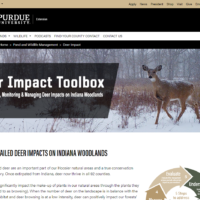
Deer can significantly impact the make-up of plants in our natural areas through the plants they eat (referred to as browsing). When the number of deer on the landscape is in balance with the available habitat and deer browsing is at a low intensity, deer can positively impact our forests’ plant diversity. When deer are overabundant, their browsing can impact forests in a variety of negative ways.
5 Steps to address deer impacts to Indiana Woodlands:
Understanding
Understand how deer impact Indiana’s forest ecosystems.
Identify
Identify signs and symptoms of deer impact in your woodland.
Monitor
Monitor how deer are impacting your woodland over time.
Manage
Decide how to manage deer and their impact on your woodland.
Evaluate
Evaluate if the management actions you took reduced deer impact on your woodland.
Check out the new Deer Impact Toolbox website for publications and more details to discover the steps landowners and land managers can take to understand, monitoring, and manage deer impacts to Indiana’s forests.
Don’t miss the videos: Monitoring Deer Impacts on Indiana Forests: Ten-Tallest Method and Monitoring Deer Impacts on Indiana Forests: Accessing Vegetation Impacts for Deer (AVID) Plots.
Check out the College of Agriculture news article to learn more: Deer Impact Toolbox provides guidance for Indiana forest landowners and managers.
Resources:
Purdue Extension Pond and Wildlife Management
Understanding White-tailed Deer and Their Impact on Indiana Woodlands, The Education Store
Monitoring White-tailed Deer and Their Impact on Indiana Woodlands, The Education Store
Managing White-tailed Deer Impacts on Indiana Woodlands, The Education Store
Ask an Expert: Wildlife Food Plots, video, Purdue Extension – FNR YouTube Channel
How to Build a Plastic Mesh Deer Exclusion Fence, The Education Store
Managing Your Woods for White-Tailed Deer, The Education Store
Bovine Tuberculosis in Wild White-tailed Deer, The Education Store
Handling Harvested Game: Episode 1, Field Dressing, video, Purdue Extension – FNR YouTube Channel
Deer Harvest Data Collection, Got Nature? Blog, Purdue Extension – FNR
How to Score Your White-tailed Deer, video, The Education Store, Purdue Extension Resource Center
White-Tailed Deer Post Harvest Collection, video, The Education Store
Age Determination in White-tailed Deer, video, The Education Store
Handling Harvested Deer Ask an Expert? video, Purdue Extension – FNR YouTube Channel
Subscribe to Purdue Extension-Forestry & Natural Resources YouTube Channel, Wildlife Playlist
Jarred Brooke, Wildlife Extension Specialist
Purdue Department of Forestry and Natural Resources
In this edition of ID That Tree, we’re going to introduce you to a very rare Indiana shrub that’s a relic of the ice age here, and that is Canada yew. It’s only found in Indiana on very steep slopes, rock faces, and cliffs. It’s an evergreen, so it is coniferous. It’s also very palatable to deer, so deer browse has been very hard on this particular shrub.
If you have any questions regarding wildlife, trees, forest management, wood products, natural resource planning or other natural resource topics, feel free to contact us by using our Ask an Expert web page.
Resources:
ID That Tree, Playlist, Purdue Extension – Forestry and Natural Resources (FNR) YouTube Channel (Invasive White Mulberry, Siberian Elm, Tree of Heaven)
Invasive Species Playlist, Playlist, Purdue Extension – FNR YouTube Channel (Asian Bush Honeysuckle, Burning Bush, Callery Pear, Multiflora rose)
A Woodland Management Moment, Playlist, Purdue Extension – FNR YouTube Channel (Against Invasives, Garlic Mustard, Autumn Olive)
Woodland Stewardship for Landowners, Playlist, Purdue Extension – FNR YouTube Channel (Common Buckthorn, Japanese Barberry)
How long do seeds of the invasive tree, Ailanthus altissima remain viable? (Invasive Tree of Heaven), USDA Forest Service
Indiana Department of Natural Resources: Invasive Species
Indiana Invasive Species Council
Cooperative Invasive Species Management Area (CISMA)
Report Invasive, Purdue Extension
Aquatic Invasive Species, Illinois-Indiana Sea Grant (IISG)
Episode 11 – Exploring the challenges of Invasive Species, Habitat University-Natural Resource University
What are invasive species and why should I care?, Got Nature? Blog, Purdue Extension – FNR
Shrubs and Woody Vines of Indiana and the Midwest, The Education Store, Purdue Extension Resource Center
Native Trees of the Midwest, The Education Store
Investing in Indiana Woodlands, The Education Store
Professional Forester, Indiana Forestry Woodland Owners Association
District Forester 10+acres of woodlands, Indiana Department of Natural Resources
Forest Improvement Handbook, The Education Store
Lenny Farlee, Extension Forester
Hardwood Tree Improvement and Regeneration Center
Purdue Department of Forestry & Natural Resources
Observing the colors and patterns of blooming plants is an enjoyable spring activity that reinforces the plant world is becoming active after the long pause of winter. Most mature flowering plants produce some sort of flower structure, but some are more noticeable than others. Some of the earliest among native Indiana trees are red and silver maple, the elms, serviceberry and Ohio buckeye. Some of the showiest blooms are found on redbud, flowering dogwood, tuliptree and magnolias. Keeping a journal of when first blooms are sighted or taking date-stamped photos is a good way to track this sign of spring from year to year and give you a hint of when future blooms may happen.
There is also a substantial show on the forest floor. Early-blooming wildflowers emerge and bloom before trees and shrubs expand leaves, allowing them access to sunlight in early spring. Some plants to look for include spring beauty, trilliums, Dutchman’s’ breeches, and bloodroot. Tree, shrub and plant field guides as well as plant ID apps can help you learn the ID features and life histories of these native plants.
Check out our Purdue Extension YouTube Channel to learn from Lenny Farlee, Extension Forester. In this Purdue Extension-FNR “YouTube Shorts” video below you will learn about early blooming trees in the spring time.
Resources:
ID That Tree, Playlist, Purdue Extension – Forestry and Natural Resources (FNR) YouTube Channel
Invasive Species Playlist, Playlist, Purdue Extension – FNR YouTube Channel (Asian Bush Honeysuckle, Burning Bush, Callery Pear, Multiflora rose)
A Woodland Management Moment, Playlist, Purdue Extension – FNR YouTube Channel (Against Invasives, Garlic Mustard, Autumn Olive)
Woodland Stewardship for Landowners, Playlist, Purdue Extension – FNR YouTube Channel (Common Buckthorn, Japanese Barberry)
Indiana Department of Natural Resources: Invasive Species
Indiana Invasive Species Council
Cooperative Invasive Species Management Area (CISMA)
Report Invasive, Purdue Extension
Aquatic Invasive Species, Illinois-Indiana Sea Grant (IISG)
Episode 11 – Exploring the challenges of Invasive Species, Habitat University-Natural Resource University
What are invasive species and why should I care?, Got Nature? Blog, Purdue Extension – FNR
Shrubs and Woody Vines of Indiana and the Midwest, The Education Store, Purdue Extension Resource Center
Native Trees of the Midwest, The Education Store
Lenny Farlee, Extension Forester
Hardwood Tree Improvement and Regeneration Center
Purdue Department of Forestry & Natural Resources
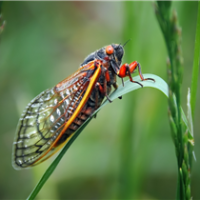 WRTV, Indianapolis News and Headlines: WEST LAFAYETTE — Elizabeth Long loves bugs.
WRTV, Indianapolis News and Headlines: WEST LAFAYETTE — Elizabeth Long loves bugs.
And she wants you to know that this summer is going to be huge for bug lovers, thanks to the emergence of two special broods of cicadas, which hasn’t happened in more than two centuries.
“That’s really, really exciting for these periodical cicadas, these two broods that are going to be emerging this year,” said Long, a Purdue University assistant professor of entomology.
“The big deal is the fact that they will be emerging in synchrony for the first time (since 1803). It’s a really long time.”
Long has a doctorate from the University of Missouri in plant, insect and microbial sciences and specializes in managing pests and beneficial bugs on farms and orchards.
And just how much does Long love bugs?
Well, she described the big green-and-black cicadas we see every summer in Central Indiana as “cute.”
“They’re green, they have a white belly,” she said. “I think they’re very cute. They’re very clumsy, you know.”
Long said these two broods of cicadas will be emerging in southern and northern parts of Indiana for about a month starting in May, then they’re gone.
WRTV asked Long about this summer’s ridiculously rare emergence of the 17-year Brood XIII (or Brood 13) and the 13-year Brood XIX (Brood 19) cicadas.
Question: What’s so special about the cicadas we are going to see this summer?
Long: We don’t have many insects that stay underground as immatures for this long, you know. It’s I think pretty amazing. So that’s really, really exciting for these periodical cicadas, these two broods that are going to be emerging this year. The big deal is the fact that they will be emerging in synchrony for the first time (since 1803). It’s a really long time.
The main difference between the two broods is the time that they spend (before) they emerge. So one is a 13-year brood and, it’s a little confusing because… the two broods that are going to emerge are Brood 19 (Brood XIX) and Brood 13 (Brood XIII).
Brood 19, which is just the number assigned to this group that emerges, those are 13 year cicadas… Then Brood 13, which is a little bit confusing… they emerge every 17 years.
So you can see that 13-17 overlap. That’s how we’re in that coincidence with the synchrony based on the math of them emerging both at the same time this year.
It so weird that 19 is 13 (years) and 13 is (17 years). I had to read up on it to get it straight.
WRTV: No wonder you guys have to get advanced degrees to understand bugs.
Long: Everyone thinks they’re simple… I’m like, these insects, they keep it challenging.
To see the full article, please visit WRTV Indianapolis News and Headlines.
Resources:
Periodical Cicadas, Indiana Department of Natural Resources, Division of Entomology
Billions of Cicadas Are Coming This Spring; What Does That Mean for Wildlife?, Got Nature? Blog, Purdue Extension-Forestry and Natural Resources (FNR)
17 Ways to Make the Most of the 17-year Cicada Emergence, Purdue College of Agriculture
Ask an Expert: Cicada Emergence Video, Got Nature? Blog, Purdue Extension-FNR
Periodical Cicada in Indiana, The Education Store, Purdue Extension resource center
Cicada Killers, The Education Store
Purdue Cicada Tracker, Purdue Extension-Master Gardener Program
Cicada, Youth and Entomology, Purdue Extension
Indiana Department of Entomology and Plant Pathology
Vic Ryckaert, Digital Reporter
WRTV Indianapolis
Elizabeth Y. Long, Assistant Professor
Purdue University Department of Entomology
Invasive species are any plant, animal, insect or plant disease not native to a specific location that can cause harm to the environment, impact the diversity of native species, reduce wildlife habitat or disrupt important ecosystem functions.
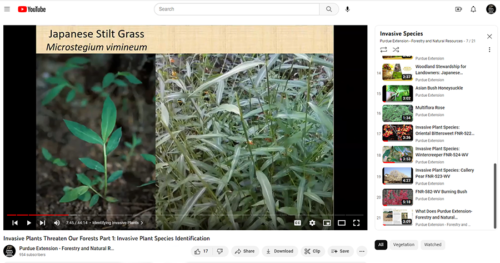 Why should you care about invasive species? Invasive species limit land use, degrade natural resources and inhibit recreational pursuits such as hunting, fishing, bird watching, and foraging. They also negatively impact fisheries, agricultural and forestry industries, destabilize soil and alter water resources. Invasive species also out compete natives and are costly to control with estimates showing that the U.S. spends $137 billion/year to control/manage invasive species.
Why should you care about invasive species? Invasive species limit land use, degrade natural resources and inhibit recreational pursuits such as hunting, fishing, bird watching, and foraging. They also negatively impact fisheries, agricultural and forestry industries, destabilize soil and alter water resources. Invasive species also out compete natives and are costly to control with estimates showing that the U.S. spends $137 billion/year to control/manage invasive species.
As spring approaches, many invasive plants will begin to leaf out in woodland areas. Spring is a good time to stop them in their tracks so they don’t overtake native plants, affect water availability or damage the quality of soil among other potential impacts.
Here are some resources to help you identify various invasive plants in woodland areas near you, to know when to report them and also what you can do help control their spread.
Videos on Purdue Extension – Forestry and Natural Resources (FNR) YouTube Channel, Invasive Species Playlist
- Asian Bush Honeysuckle
- Burning Bush
- Callery Pear
- Multiflora Rose
- Invasive Plants Threaten Our Forests Part 1: Invasive Plant Species Identification
- Invasive Plants Threaten Our Forests Part 2: Control and Management
Don’t miss this YouTube Shorts video, Lenny Farlee Talks About Invasive Plants Emerging in Early Spring
More Purdue Extension-FNR YouTube Video Series –
Woodland Management Moment:
Woodland Stewardship for Landowners:
ID That Tree:
FNR Extension Publications, The Education Store:
- Invasive Plant Species: Oriental Bittersweet
- Invasive Plant Species: Wintercreeper
- Japanese Chaff Flower
- Kudzu in Indiana
- Mile-a-minute Vine
Purdue Landscape Report:
- Alternatives to Burning Bush for Fall Color
- Now is the Time to Identify Callery Pear
- Keyword search: Invasive
FNR Extension Got Nature? Blog:
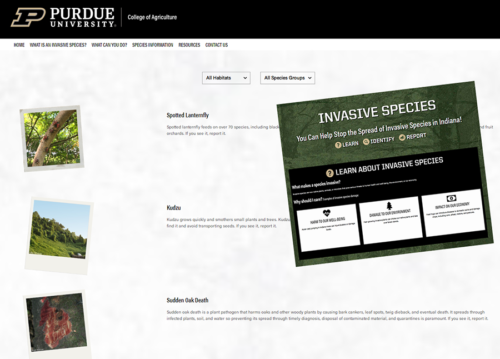 When and how do I report an invasive species?
When and how do I report an invasive species?
The Purdue Invasive Species website will help you identify invasive species and explain how to send in your findings. If you notice something is killing an otherwise healthy stand of trees or shrubs, you will want to identify it and report it if it is on the invasive list. If you see a plant that is taking over an area where it doesn’t belong, you will want to identify it and report it if it is on the invasive list.
- The GLEDN Phone App – Great Lakes Early Detection Network
- EDDMaps – Early Detection and Distribution Mapping System
- 1-866 No EXOTIC (1-866-663-9684)
- depp@dnr.IN.gov – Email Indiana Department of Natural Resources (DNR)
More Resources
Indiana Department of Natural Resources: Invasive Species
Indiana Invasive Species Council
Cooperative Invasive Species Management Area (CISMA)
Aquatic Invasive Species, Illinois-Indiana Sea Grant (IISG)
Episode 11 – Exploring the challenges of Invasive Species, Habitat University-Natural Resource University
Emerald Ash Borer Information Network, Purdue University and Partners
What Nurseries Need to Know About the Invasive Species Regulation, The Education Store, Purdue Extension’s resource center
Invasive plants: impact on environment and people, The Education Store, Purdue Extension’s resource center
Diana Evans, Extension and Web Communication Specialist
Purdue University Department of Forestry and Natural Resources
Lenny Farlee, Extension Forester
Hardwood Tree Improvement and Regeneration Center
Purdue Department of Forestry & Natural Resources
In this edition of ID That Tree, we’re going to introduce you to yet another native Indiana elm found in the far southwest corner of Indiana, and that is winged elm. It’s named for its prominent corky ridges that we see extending off the main stems and twigs. It has alternate leaf arrangement, simple leaves, and doubly serrated margins.
If you have any questions regarding wildlife, trees, forest management, wood products, natural resource planning or other natural resource topics, feel free to contact us by using our Ask an Expert web page.
Resources:
Winged Elm, Native Trees of Indiana River Walk, Purdue Fort Wayne
ID That Tree, Playlist, Purdue Extension – Forestry and Natural Resources (FNR) YouTube Channel (Invasive White Mulberry, Siberian Elm, Tree of Heaven)
Invasive Species Playlist, Playlist, Purdue Extension – FNR YouTube Channel (Asian Bush Honeysuckle, Burning Bush, Callery Pear, Multiflora rose)
A Woodland Management Moment, Playlist, Purdue Extension – FNR YouTube Channel (Against Invasives, Garlic Mustard, Autumn Olive)
Woodland Stewardship for Landowners, Playlist, Purdue Extension – FNR YouTube Channel (Common Buckthorn, Japanese Barberry)
How long do seeds of the invasive tree, Ailanthus altissima remain viable? (Invasive Tree of Heaven), USDA Forest Service
Indiana Department of Natural Resources: Invasive Species
Indiana Invasive Species Council
Cooperative Invasive Species Management Area (CISMA)
Report Invasive, Purdue Extension
Aquatic Invasive Species, Illinois-Indiana Sea Grant (IISG)
Episode 11 – Exploring the challenges of Invasive Species, Habitat University-Natural Resource University
What are invasive species and why should I care?, Got Nature? Blog, Purdue Extension – FNR
Shrubs and Woody Vines of Indiana and the Midwest, The Education Store, Purdue Extension Resource Center
Native Trees of the Midwest, The Education Store
Investing in Indiana Woodlands, The Education Store
Professional Forester, Indiana Forestry Woodland Owners Association
District Forester 10+acres of woodlands, Indiana Department of Natural Resources
Forest Improvement Handbook, The Education Store
Lenny Farlee, Extension Forester
Hardwood Tree Improvement and Regeneration Center
Purdue Department of Forestry & Natural Resources
Wild Bulletin, Indiana Department of Natural Resources (DNR) Fish and Wildlife: IN DNR providing public online forms to submit your comments regarding proposed changes on two regulations for the state.
Public Comment Period Open for Proposed Changes to Deer Hunting Rules: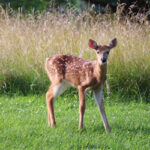
Indiana’s Natural Resources Commission (NRC) has opened a public comment period for proposed changes to Indiana’s deer hunting rules before they vote on the proposed changes. Most proposed changes intend to simplify Indiana’s deer hunting rules so they are easier to understand.
Public comments can be submitted online. Locate the “Submit Comments Here” link in the Rules Docket for the Deer Hunting Rule Amendments Proposal. The deadline for public comments is March 20. The public hearing will be held on Wednesday, March 20, from 4–8 p.m. ET both online and in person at the Fort Harrison State Park Inn’s Roosevelt Ballroom. To attend the public hearing online, go to Microsoft Teams and enter Meeting ID: 296 491 887 327, Passcode: xTCuyW starting at 4 p.m. ET on March 20.
For more information on the proposed rule changes, visit the Indiana Department of Natural Resources’ rule and regulations changes web page. Questions about the proposed deer hunting rule changes should be directed to 812-334-3795 or indeerhotline@dnr.IN.gov.
Public Comment Period Open for Proposed Changes to River Otter Trapping Rules:
The Natural Resources Commission (NRC) has opened a public comment period for proposed changes to Indiana’s river otter trapping rule before they vote on final adoption of the proposed changes.
Indiana DNR is proposing to open otter trapping statewide but keep all other otter regulations the same. The proposed changes will allow otters to be trapped statewide, allowing people to handle emerging wildlife conflicts in all counties and simplify the otter regulations. The DNR is confident the change will not negatively affect river otter populations, which staff will continue to monitor.
Public comments can be submitted online. Locate the “Comment on this rule” link in the Rule Docket for the River Otter Trapping Rule. The deadline for public comments is April 11.
Questions about the proposed otter trapping rule changes should be directed to Geriann Albers at 812-822-3304 or galbers@dnr.IN.gov. Visit the Indiana Department of Natural Resources website for more information on the proposed rule changes.
To learn more please visit Indiana Natural Resources Commission – Rulemaking Docket.
Resources:
Creating a Wildlife Habitat Management Plan for Landowners, The Education Store, Purdue Extension’s resource center
A Template for Your Wildlife Habitat Management Plan, The Education Store
Wildlife Habitat Hint: Trail Camera Tips and Tricks, Got Nature? Blog
Forest Improvement Handbook, The Education Store
Designing Hardwood Tree Plantings for Wildlife – The Education Store
ID That Tree – YouTube Playlist
Hunting Guide for 2023-2024, Indiana Department of Natural Resources
How to Score Your White-tailed Deer, video, The Education Store, Purdue Extension Resource Center
White-Tailed Deer Post Harvest Collection, video, The Education Store
Age Determination in White-tailed Deer, video, The Education Store
How to Build a Plastic Mesh Deer Exclusion Fence, The Education Store
Forest Management for Reptiles and Amphibians: A Technical Guide for the Midwest, The Education Store
Ask the Expert: Hardwood Ecosystem Experiment – Birds and Salamander Research, Purdue Extension – FNR
A Template for Your Wildlife Habitat Management Plan, The Education Store
Managing Your Woods for White-Tailed Deer, The Education Store
Indiana Department of Natural Resources
In this edition of ID That Tree, we’re going to introduce you to yet another southern Indiana oak species. This one is a member of the broad white oak group and it’s called post oak. It’s called that because it’s a very rot resistant and hard wood that used to be used for fence posts. It has rounded lobes, no bristle tips, and typified by a cruciform shape of leaf.
If you have any questions regarding wildlife, trees, forest management, wood products, natural resource planning or other natural resource topics, feel free to contact us by using our Ask an Expert web page.
Resources:
Post Oak, Native Trees of Indiana River Walk, Purdue Fort Wayne
ID That Tree, Playlist, Purdue Extension – Forestry and Natural Resources (FNR) YouTube Channel (Invasive White Mulberry, Siberian Elm, Tree of Heaven)
Invasive Species Playlist, Playlist, Purdue Extension – FNR YouTube Channel (Asian Bush Honeysuckle, Burning Bush, Callery Pear, Multiflora rose)
A Woodland Management Moment, Playlist, Purdue Extension – FNR YouTube Channel (Against Invasives, Garlic Mustard, Autumn Olive)
Woodland Stewardship for Landowners, Playlist, Purdue Extension – FNR YouTube Channel (Common Buckthorn, Japanese Barberry)
How long do seeds of the invasive tree, Ailanthus altissima remain viable? (Invasive Tree of Heaven), USDA Forest Service
Indiana Department of Natural Resources: Invasive Species
Indiana Invasive Species Council
Cooperative Invasive Species Management Area (CISMA)
Report Invasive, Purdue Extension
Aquatic Invasive Species, Illinois-Indiana Sea Grant (IISG)
Episode 11 – Exploring the challenges of Invasive Species, Habitat University-Natural Resource University
What are invasive species and why should I care?, Got Nature? Blog, Purdue Extension – FNR
Shrubs and Woody Vines of Indiana and the Midwest, The Education Store, Purdue Extension Resource Center
Native Trees of the Midwest, The Education Store
Investing in Indiana Woodlands, The Education Store
Professional Forester, Indiana Forestry Woodland Owners Association
District Forester 10+acres of woodlands, Indiana Department of Natural Resources
Forest Improvement Handbook, The Education Store
Lenny Farlee, Extension Forester
Hardwood Tree Improvement and Regeneration Center
Purdue Department of Forestry & Natural Resources
In this edition of ID That Tree, we’re going to introduce you to a southern oak found in Indiana, cherrybark oak. This species can typically be found in bottomland areas in extreme southern Indiana. It’s a member of the broad red oak group. It has hairlike bristle tips, relatively large leaves, a waxy coating on the top, and lobes that have one or tow hair-like spines on the end.
If you have any questions regarding wildlife, trees, forest management, wood products, natural resource planning or other natural resource topics, feel free to contact us by using our Ask an Expert web page.
Resources:
Cherrybark Oak, Native Trees of Indiana River Walk, Purdue Fort Wayne
ID That Tree, Playlist, Purdue Extension – Forestry and Natural Resources (FNR) YouTube Channel (Invasive White Mulberry, Siberian Elm, Tree of Heaven)
Invasive Species Playlist, Playlist, Purdue Extension – FNR YouTube Channel (Asian Bush Honeysuckle, Burning Bush, Callery Pear, Multiflora rose)
A Woodland Management Moment, Playlist, Purdue Extension – FNR YouTube Channel (Against Invasives, Garlic Mustard, Autumn Olive)
Woodland Stewardship for Landowners, Playlist, Purdue Extension – FNR YouTube Channel (Common Buckthorn, Japanese Barberry)
How long do seeds of the invasive tree, Ailanthus altissima remain viable? (Invasive Tree of Heaven), USDA Forest Service
Indiana Department of Natural Resources: Invasive Species
Indiana Invasive Species Council
Cooperative Invasive Species Management Area (CISMA)
Report Invasive, Purdue Extension
Aquatic Invasive Species, Illinois-Indiana Sea Grant (IISG)
Episode 11 – Exploring the challenges of Invasive Species, Habitat University-Natural Resource University
What are invasive species and why should I care?, Got Nature? Blog, Purdue Extension – FNR
Shrubs and Woody Vines of Indiana and the Midwest, The Education Store, Purdue Extension Resource Center
Native Trees of the Midwest, The Education Store
Investing in Indiana Woodlands, The Education Store
Professional Forester, Indiana Forestry Woodland Owners Association
District Forester 10+acres of woodlands, Indiana Department of Natural Resources
Forest Improvement Handbook, The Education Store
Lenny Farlee, Extension Forester
Hardwood Tree Improvement and Regeneration Center
Purdue Department of Forestry & Natural Resources
Recent Posts
- Summer Tree Care – Purdue Landscape Report
Posted: July 16, 2024 in Forestry, Forests and Street Trees, How To, Plants, Urban Forestry - ID That Tree: Types of Broadleaved Tree Leaves
Posted: July 10, 2024 in Forestry, Forests and Street Trees, How To, Plants, Wildlife - Case Study: Maple Tree Pests – Purdue Landscape Report
Posted: June 26, 2024 in Disease, Forests and Street Trees, Plants, Spiders, Urban Forestry, Wildlife, Woodlands - Indiana’s Surprise Onion Plants Emerge
Posted: June 20, 2024 in Forestry, Forests and Street Trees, Plants, Urban Forestry, Wildlife, Woodlands - Publication – Introduction to White-tailed Deer Impacts on Indiana Woodlands
Posted: April 28, 2024 in Forestry, Land Use, Plants, Publication, Wildlife, Woodlands - Publication – Understanding White-tailed Deer and Their Impact on Indiana Woodlands
Posted: in Forestry, Land Use, Plants, Publication, Wildlife, Woodlands - Publication – Monitoring White-tailed Deer and Their Impact on Indiana Woodlands
Posted: in Forestry, Land Use, Plants, Publication, Wildlife, Woodlands - Publication – Managing White-tailed Deer Impacts on Indiana Woodlands
Posted: in Forestry, Land Use, Plants, Publication, Wildlife, Woodlands - Report Spotted Lanternfly – Purdue Landscape Report
Posted: April 10, 2024 in Alert, Forestry, Invasive Insects, Plants, Wildlife, Woodlands - Declining Pines of the White Variety – Purdue Landscape Report
Posted: in Alert, Disease, Forestry, Plants, Wildlife, Woodlands
Archives
Categories
- Alert
- Aquaculture/Fish
- Aquatic/Aquaculture Resources
- Ask the Expert
- Christmas Trees
- Community Development
- Disease
- Drought
- Forestry
- Forests and Street Trees
- Gardening
- Got Nature for Kids
- Great Lakes
- How To
- Invasive Animal Species
- Invasive Insects
- Invasive Plant Species
- Land Use
- Natural Resource Planning
- Nature of Teaching
- Plants
- Podcasts
- Ponds
- Publication
- Safety
- Spiders
- Timber Marketing
- Uncategorized
- Urban Forestry
- Webinar
- Wildlife
- Wood Products/Manufacturing
- Woodland Management Moment
- Woodlands

